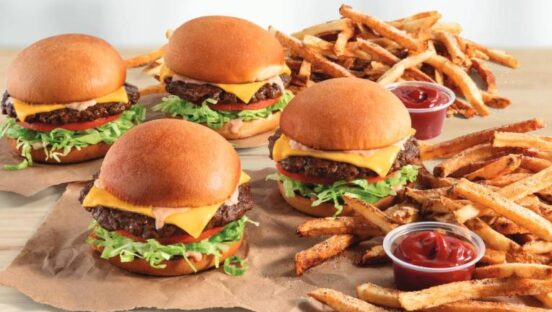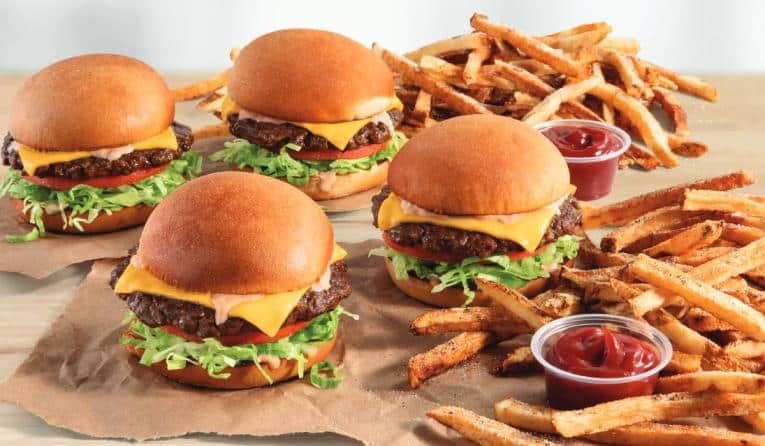Doug Willmarth, CEO of MOOYAH Burgers, Fries & Shakes, has an interest in building franchise success for the next 20 years. The goal is a difficult one. Throw in an operating environment where rates are going up and real estate is slim, the path becomes incredibly narrow.
The chain entered 2023 with 78 U.S.-based restaurants, with all but one being franchised. It lost a net of three stores last year, after gaining a net of three in 2021 and two in 2020. As of early October, the website listed about 70 domestic units across 22 states. The brand’s U.S. footprint hasn’t been that low since the start of 2015.
Willmarth says the fast casual is still garnering “a lot of interest” in the face of economic challenges. With uncertainty still out there, MOOYAH leaders felt it was important to partner with operators to ensure they had a wider chance to be successful. The brand figures that if it puts skin in the game, franchisees will be quicker to open their second, third, and even fourth restaurants.
So the brand created a multi-faceted franchise incentive package to get the ball rolling on development deals. The first aspect is mitigating higher start-up costs by putting more money in franchisees’ pockets. MOOYAH’s royalty rate is 6 percent, but for each new store agreement, operators pay 3 percent in their first year, 4 percent in their second year, and 5 percent in their third year. The brand will also partner with franchisees on grand opening marketing by matching the first $5,000 investment dollar-for-dollar. For multi-unit franchisees, up to three outlets can be part of the program.
“We really believe that a good marketing investment in the first six to 12 months is really important to get awareness out there and get people in the door and trying our product because we have the best cheeseburger in the world,” Willmarth says. “We know that’s going to sell when people eat it. … We’re very passionate about people spending at least $10,000 behind marketing as they open their restaurant.”
MOOYAH has seen a roughly 50 percent increase in franchise applications since announcing the incentives. A handful of development deals are currently pending and there are a few more in discussion.

In some cases, existing operators without a development obligation wanted to get into the game. For instance, the multi-store franchisee in Madison, Wisconsin, began looking for sites after the incentive was announced. The restaurateur is scheduled to open another location in October.
“I’ve had six or seven franchise groups—that did not have plans to grow—decide to add another location because of the incentive,” Willmarth says. “And that’s been a great response. Any time you can have your long-time successful franchisees who see what you’re doing and believe in it enough to add more locations, that’s a good indication you’re on the right track.”
MOOYAH is on pace to finish 2022 with eight opened restaurants, after predicting it would open 14 stores, according to its FDD. Willmarth attributes the lower-than-anticipated figure to longer timelines around permitting, construction, lease negotiations, and the loan approval process at banks. The process of debuting stores, which typically took six months, now takes approximately eight to nine months. That wider stretch will kick some openings into Q1 of next year.
Willmarth is expecting 20-22 new locations in 2024. MOOYAH hasn’t opened that many locations in a calendar year in over a decade. The brand is focused on building in existing markets, which span from California to Florida. There’s organic interest in the Midwest corridor; the CEO says a franchisee in St. Louis will likely open two units next year. Another deal is pending in Michigan.
MOOYAH is equipping franchisees with slimmer prototypes, kiosk ordering, and updated digital offerings to compete in the changing quick-service landscape. The company upgraded the engine behind its online ordering system and launched an enhanced version of its mobile app and loyalty program. Guests now earn one point per dollar spent with reward tiers of 25, 50, 75, and 100. Previously MOOYAH used a banked dollar system that gave customers a $10 credit after they earned 100 points.
“We find that people really like that type of architecture where I know that as I earn points eventually, if I come four or five times, I’ll be able to get a free burger on my fifth or sixth visit,” Willmarth says. “I think that’s been a little bit easier for people to wrap their heads around.”


Endcap drive-thru restaurants, anywhere from 1,800 to 2,200 square feet, are becoming a bigger target for MOOYAH as well. Corporate is building one in Dallas. Two other stores with leases will go under construction toward the end of next year. However, within these designs, MOOYAH leaves room for a comfortable dining room. Roughly half of the business is on-premises; even if that shot down to 40 percent, Willmarth would still find the dining room valuable. It’s a big part of what separated fast food and fast casual before the pandemic, and the CEO wants to keep that higher hospitality status intact.
“It’s important for us to have somebody there to welcome you in and help you with the order if you want to walk up and have a person take your order,” Willmarth says. “I know some of my competitors want to go to all kiosks and automate everything. Our point of view is we’re a community operator. We believe in hospitality. We want to be the place where you can still come in and talk to a person and get a smile and we want to check in on you and make sure your food’s great. We’re going to continue to invest in hospitality and community involvement rather than going down a track of trying to be just drive-thru or just digital only. I think that as an industry, we will be poorer off if we lose the hospitality aspect.”
MOOYAH also differentiates itself with handcrafted burgers made with fresh bread and certified Angus beef. The chain will make them however you want—gluten-free bun, vegan bun, lettuce bun, beef patties, turkey patties, veggie patties, five types of cheese, and several other toppings. A list of signature burgers is in MOOYAH’s “Hall of Dang,” a tongue-in-cheek secret menu. The items are ones that customers wouldn’t think to create themselves, Willmarth says. One example is the Hamburdog, featuring a certified Angus beef patty topped with an all-beef hot dog, cheddar cheese, bacon, jalapeños, fried onion strings, ketchup, and a signature potato bun.
The brand’s primary mission is to “serve the best cheeseburger in America,” according to Willmarth. That’s how most operators fall in love with the brand to begin with.
“We got a franchisee in for Discovery Day, and his story is the same as most that I hear is that they walk in, they tried the burger, and they’re like, ‘That’s the best burger I’ve ever had. How do I get into that?'” Willmarth says. “And because of that, we have people that passionately believe in our brand and our product. I think that ultimately is going to be the key to success. They’re not trying to run 100 people to the drive-thru. They’re making great burgers, serving people. That’s the business that we want to be in.”








